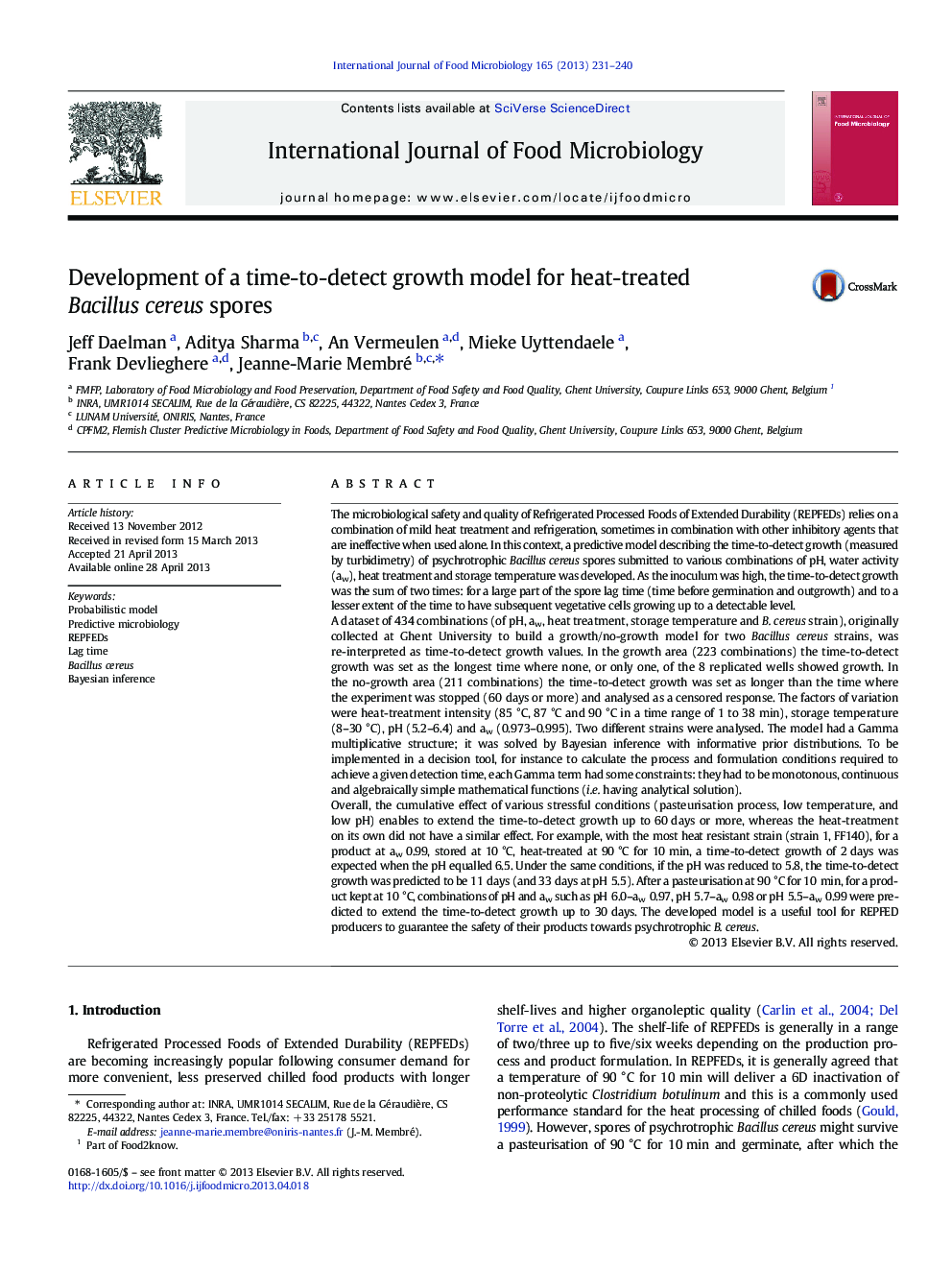| کد مقاله | کد نشریه | سال انتشار | مقاله انگلیسی | نسخه تمام متن |
|---|---|---|---|---|
| 4367268 | 1616620 | 2013 | 10 صفحه PDF | دانلود رایگان |

• A model describing the time-to-detect growth of Bacillus cereus heat-treated spores was developed.
• The factors were pH, water activity, heat treatment and chilled storage temperature
• The Gamma-type model structure had monotonous and easy-to-solve-analytically terms.
• Combinations of process and formulation delivering a 30-day detection time are provided.
The microbiological safety and quality of Refrigerated Processed Foods of Extended Durability (REPFEDs) relies on a combination of mild heat treatment and refrigeration, sometimes in combination with other inhibitory agents that are ineffective when used alone. In this context, a predictive model describing the time-to-detect growth (measured by turbidimetry) of psychrotrophic Bacillus cereus spores submitted to various combinations of pH, water activity (aw), heat treatment and storage temperature was developed. As the inoculum was high, the time-to-detect growth was the sum of two times: for a large part of the spore lag time (time before germination and outgrowth) and to a lesser extent of the time to have subsequent vegetative cells growing up to a detectable level.A dataset of 434 combinations (of pH, aw, heat treatment, storage temperature and B. cereus strain), originally collected at Ghent University to build a growth/no-growth model for two Bacillus cereus strains, was re-interpreted as time-to-detect growth values. In the growth area (223 combinations) the time-to-detect growth was set as the longest time where none, or only one, of the 8 replicated wells showed growth. In the no-growth area (211 combinations) the time-to-detect growth was set as longer than the time where the experiment was stopped (60 days or more) and analysed as a censored response. The factors of variation were heat-treatment intensity (85 °C, 87 °C and 90 °C in a time range of 1 to 38 min), storage temperature (8–30 °C), pH (5.2–6.4) and aw (0.973–0.995). Two different strains were analysed. The model had a Gamma multiplicative structure; it was solved by Bayesian inference with informative prior distributions. To be implemented in a decision tool, for instance to calculate the process and formulation conditions required to achieve a given detection time, each Gamma term had some constraints: they had to be monotonous, continuous and algebraically simple mathematical functions (i.e. having analytical solution).Overall, the cumulative effect of various stressful conditions (pasteurisation process, low temperature, and low pH) enables to extend the time-to-detect growth up to 60 days or more, whereas the heat-treatment on its own did not have a similar effect. For example, with the most heat resistant strain (strain 1, FF140), for a product at aw 0.99, stored at 10 °C, heat-treated at 90 °C for 10 min, a time-to-detect growth of 2 days was expected when the pH equalled 6.5. Under the same conditions, if the pH was reduced to 5.8, the time-to-detect growth was predicted to be 11 days (and 33 days at pH 5.5). After a pasteurisation at 90 °C for 10 min, for a product kept at 10 °C, combinations of pH and aw such as pH 6.0–aw 0.97, pH 5.7–aw 0.98 or pH 5.5–aw 0.99 were predicted to extend the time-to-detect growth up to 30 days. The developed model is a useful tool for REPFED producers to guarantee the safety of their products towards psychrotrophic B. cereus.
Journal: International Journal of Food Microbiology - Volume 165, Issue 3, 1 August 2013, Pages 231–240